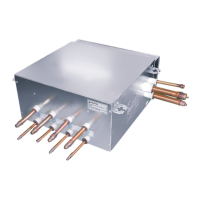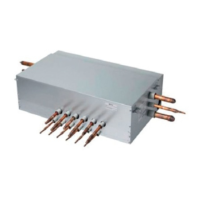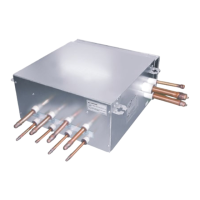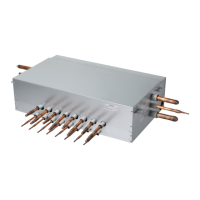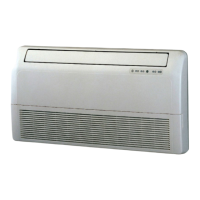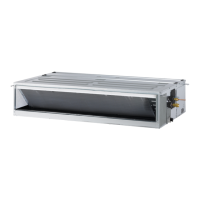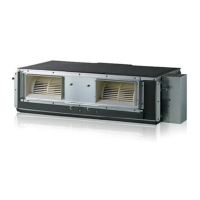9
ENGLISH
Flare shape and flare nut tightening torque
Precautions when connecting pipes
- See the following table for flare part machining dimensions.
- When connecting the flare nuts, apply refrigerant oil to the inside and
outside of the flares and turn them three or four times at first. (Use
ester oil or ether oil.)
-
See the following table for tightening torque. (Applying too much torque may
cause the flares to crack.)
- After all the piping has been connected, use nitrogen to perform a
gas leak check.
CAUTION
!
• Always use a charge hose for service port connection.
•
After tightening the cap, check that no refrigerant leaks are present
.
• When loosening a flare nut, always use two wrenches in
combination, When connecting the piping,
always use a spanner and torque wrench
in combination to tighten the flare nut.
• When connecting a flare nut, coat the
flare(inner and outer faces) with oil for
R410A(PVE) and hand tighten the nut
3 to 4 turns as the initial tightening.
pipe size
[mm(inch)]
Tightening Torque
N·m (lbs ·ft)
A [mm(inch)] Flare shape
Ø 9.52 (3/8) 38±4 (28±3.0) 12.8 (0.5)~13.2 (0.52)
90°
±2
45°
±2
A
R=0.4~0.8
Ø 12.7 (1/2) 55±6 (41±4.4)
16.2 (0.64)~16.6 (0.65)
Ø 15.88 (5/8)
75±7 (55±5.2)
19.3 (0.76)~19.7 (0.78)
Opening shutoff valve
1 Remove the cap and turn the valve counter clockwise with the
wrench.
2 Turn it until the shaft stops.
Do not apply excessive force to the shutoff valve. Doing so may
break the valve body, as the valve is not a backseat type. Always
use the special tool.
3 Make sure to tighten the cap securely.
Heat insulation
1 Use the heat insulation material for the refrigerant piping which has
an excellent heat-resistance (over 248 °F).
2 Precautions in high humidity circumstance:
This air conditioner has been tested according to the "ISO
Conditions with Mist" and confirmed that there is not any default.
However, if it is operated for a long time in high humid atmosphere
(dew point temperature: more than 73.4 °F), water drops are liable
to fall. In this case, add heat insulation material according to the
following procedure:
- Heat insulation material to be prepared... EPDM (Ethylene
Propylene Diene Methylene)-over 248 °F the heat-resistance
temperature.
- Add the insulation over 10 mm (0.39 inch) thickness at high
humidity environment.
Closing shutoff valve
1 Remove the cap and turn the valve clockwise with the wrench.
2 Securely tighten the valve until the shaft contacts the main body seal.
3 Make sure to tighten the cap securely.
* For the tightening torque, refer to the table on the below.
Tightening torque
Shut off
valve size
[mm(inch)]
Tightening torque N·m(lbs ·ft)(Turn clockwise to close)
Shaft(valve body)
Cap
(Valve lid)
Service
port
Flare nut
Gas line
piping
attached to
unit
Closed Opened
Hexagonal
wrench
Ø 6.35
(1/4)
6.0 ±0.6
(4.4±0.4)
5.0 ±0.0
(3.7±0.4)
4 mm
(0.16 inch)
17.6±2.0
(13.0±1.5)
12.7±2
(9.4±1.5)
16±2
(12±1.5)
-
Ø 9.52
(3/8)
38±4
(28±3.0)
Ø 12.7
(1/2)
10.0 ±1.0
(7.4±0.7)
20.0±2.0
(14.8±1.5)
55±6
(41±4.4)
Ø 15.88
(5/8)
12.0 ±1.2
(8.9±0.9)
5 mm
(0.24 inch)
25.0±2.5
(18.4±1.8)
75±7
(55±5.1)
Ø 19.05
(3/4)
14.0 ±1.4
(10.3±1.0)
110±10
(81.1±7.4)
Ø 22.2
(7/8)
30.0 ±3.0
(22.1±2.2)
8 mm
(0.31 inch)
-
25±3.0
(18.5±2.2)
Ø 25.4
(1.0)
Plumbing materials and storage methods
Pipe must be able to obtain the specified thickness and should be
used with low impurities.
Also when handling storage, pipe must be careful to prevent a
fracture, deformity and wound.
Should not be mixed with contaminations such as dust, moisture.
Refrigerant piping on three principles
Drying Cleanliness Airtight
Should be no moisture
inside
No dust inside.
There is no refrigerant
leakage
Items
Cause failure
- Significant hydrolysis
of refrigerant oil
- Degradation of
refrigerant oil
- Poor insulation of the
compressor
- Do not cold and
warm
- Clogging of EEV,
Capillary
- Degradation of
refrigerant oil
- Poor insulation of the
compressor
- Do not cold and
warm
- Clogging of EEV,
Capillary
- Gas shortages
- Degradation of
refrigerant oil
- Poor insulation of the
compressor
- Do not cold and
warm
Countermeasure
- No moisture in the
pipe
- Until the connection
is completed, the
plumbing pipe
entrance should be
strictly controlled.
- Stop plumbing at
rainy day.
- Pipe entrance should
be taken side or
bottom.
- When removal burr
after cutting pipe,
pipe entrance should
be taken down.
- Pipe entrance should
be fitted cap when
pass through the
walls.
- No dust in the pipe.
- Until the connection
is completed, the
plumbing pipe
entrance should be
strictly controlled.
- Pipe entrance should
be taken side or
bottom.
- When removal burr
after cutting pipe,
pipe entrance should
be taken down.
- Pipe entrance should
be fitted cap when
pass through the
walls.
- Airtightness test
should be.
- Brazing operations to
comply with
standards.
- Flare to comply with
standards.
- Flange connections
to comply with
standards.
Indoor unit
Thermal insulator (accessory)
Fastening band (accessory)
Refrigerant piping
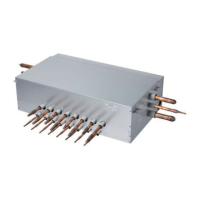
